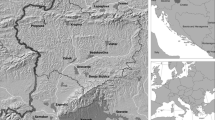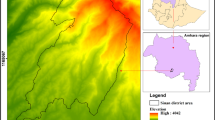Abstract
Some studies have attributed forest shrinkage to population growth, economic development, conversion of forest land to agricultural use and harvesting of trees for timber and fuelwood. But the statistical support for these hypotheses is not strong. This paper attempts to test the above hypotheses statistically in the case of Bangladesh. Factor analysis extracted 4 important factors—(a) exploitation of forests for timber, fuelwood, tea, and shrimp production, (b) demographic pressure in agriculture, (c) economic development, and (d) expansion of crop lands—as causes of deforestation. The statistical test supports the hypotheses that the exploitation of forests for timber, fuelwood, tea and shrimp production, and conversion of forests to crop lands have a negative influence on forest cover. Economic development and demographic pressure in agriculture are also negatively correlated with forest cover. Results of regression analysis show the conversion of forests to agricultural land is the most important cause of deforestation. Other important causes, in order of their relative importance, are the relative price of forest products, population growth, economic development, demographic pressure in agriculture, increasing production of shrimps, export of tea and shrimps, increasing production of timber and fuelwood, and expansion of tea lands. The statistical tests support the above relationships.
Similar content being viewed by others
Literature cited
A Task Force Report (1987) Participatory forestry in Bangladesh: Concepts, experiences and recommendations. 20pp, Ministry of Agriculture, Government of the People’s Republic of Bangladesh, Dhaka, Bangladesh.
Allen, J. C. and Barnes, D. F. (1985) The causes of deforestation in developing countries. Annu. Assoc. Am. Geogr. 75: 163–184.
Anon. (1984) Report on forest land of Chokoria Sundarbans Range. Cox’s Bazar Forest Division, Cox’s Bazer, Bangladesh. (Official Record, unpublished)
BB (1996) Economic trends. 16pp, Statistics Department, Bangladesh Bank, Dhaka, Bangladesh.
BBS (1993) Twenty years of national accounting of Bangladesh. 36–113pp, Statistics Division, Ministry of Planning, Government of the People’s Republic of Bangladesh, Dhaka, Bangladesh.
BBS (1994) Statistical Yearbook of Bangladesh. 118–428pp, Bangladesh Bureau of Statistics, Statistics Division, Ministry of Planning, Government of the People’s Republic of Bangladesh, Dhaka, Bangladesh.
Bramble, J. B. (1987) The debt crisis: The opportunities. Ecologist 17(4/5): 193.
Cartwright, J. (1989) Conserving nature, decrease debt. Third World Q. 11(2): 114–127.
Choudhury, A. M., Quadir, D. A., and Islam, J. (1990) Study of Chokoria Sundarbans using remote sensing techniques. 45pp, Bangladesh Space Research and Remote Sensing Organization (SPARRSO), Dhaka, Bangladesh.
Daniel, J.C. and Kulasingan, A. (1974) Problems arising from large-scale forest clearing for anti cultural use: The Malaysian experience. Malays. For. 37(3): 152–160.
Eckholm, E. (1982) Human wants and misused lands. Nat. Hist. 94(6):33–48.
FAO (1995) Forestry statistics today for tomorrow. 5pp, Food and Agriculture Organization of the United Nations, Rome.
FMP (1993) Environment. Forestry Master Plan. 67pp, ADB TA No. 1355-BAN, UNDP/FAO BGD/88/025.
Giri, C. and Shrestha, S. (1996) Land cover mapping and monitoring from NOAA AVHRR data in Bangladesh. Int. J. Remote Sens. 17: 2749–2759.
Gomez-Pompa, A., Vasques, C., and Guevara, S. (1972) The tropical rainforest: A non-renewable resource. Science 177: 762–769.
Guppy, N. (1984) Tropical deforestation: A global view. Foreign Aff. 62: 928–965.
Harwood, R. R. (1996) Development pathways toward sustainable systems following slash-and-burn. Agric. Ecosys. Environ. 58: 75–86.
Hossain, M. (1991) Agriculture in Bangladesh: preference, problems and prospects. 284pp, University Press Ltd. Dhaka, Bangladesh.
Huq, F. M. and Alim, A. (1995) Social forestry in Bangladesh: State of art study. 6pp, BARC-Winrock International Agroforestry & Participatory Forestry Research and Training Support Program, Dhaka, Bangladesh.
Hurst, P. (1987) Forest destruction in South East Asia. The Ecol. 17: 170–174.
Inman, K. (1993) Fueling Expansion in the Third World: Population, Development, Debt, and the Global Decline of Forests. Soc. Nat. Res. 6: 1739.
Jarosz, L. (1993) Defining and explaining tropical deforestation: Shifting cultivation and population growth in colonial Madagascar (1896–1940). Ecol. Geogr. 69: 366–379.
Lutzenberger, J. A. (1985) The World Bank’s Polonroeste project: A social and environmental catastrophe. The Ecol. 15: 69–72.
Lutzenberger, J. A. (1987) Who is destroying the Amazon rainforest? The Ecol. 17: 155–160.
Myers, N. (1982) Room in the ark? Bull. Atom. Sci. 38(9): 44–48.
Myers, N. (1983) Tropical moist forest: Over exploited and under-utilized? For. Ecol. Manage. 6: 59–79.
Ohlsson, B. (1984) Some notes on forestry production systems in Bangladesh. UNDP/FAO/Planning Commission of Bangladesh, Project BGD/78/010, FAO, Dhaka.
Rich, B. M. (1985) Multi-lateral development banks—Their role in destroying the global environment. The Ecol. 12: 56–68.
Riswan, S. and Hartanti, L. (1995) Human impacts on tropical forest dynamics. Vegetatio 121: 41–52.
Rock, T. M. (1996) The stork, the plow, rural social structure and tropical deforestation in poor countries? Ecol. Econ. 18: 113–131.
Russell, W. M. S. (1988) Population, swidden farming and the tropical environment. Pop. Environ. 10: 77–94.
Siddiqi, N. A., Shahidullah, M., and Haque, A. K. F. (1994) Present status of Chakaria Sundarbans—the oldest mangrove forest in the sub-continent. Bangladesh J. For. Sci. 23: 26–34.
Author information
Authors and Affiliations
About this article
Cite this article
Salam, M.A., Noguchi, T. Factors influencing the loss of forest cover in bangladesh: An analysis from socioeconomic and demographic perspectives. J For Res 3, 145–150 (1998). https://doi.org/10.1007/BF02762135
Accepted:
Issue Date:
DOI: https://doi.org/10.1007/BF02762135




